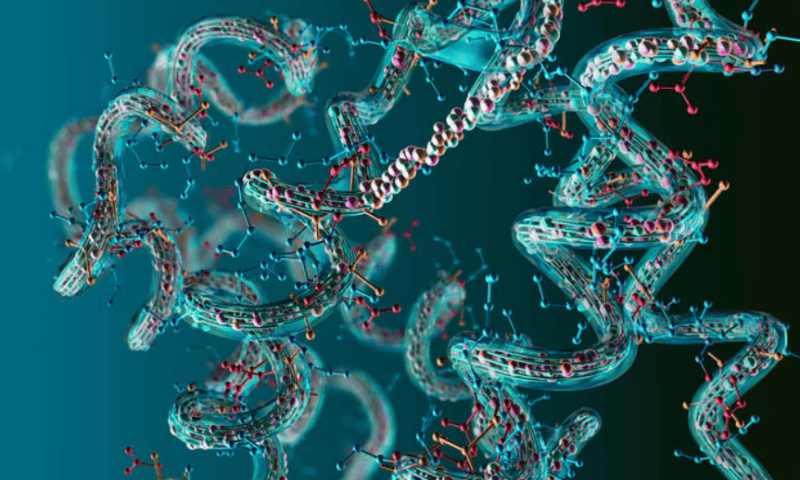A new type of immunotherapy drug appears to be more effective than other approaches at stimulating the immune response, the results of a study published April 19 in Nature Biomedical Engineering show.
In the article, scientists from the University of Texas MD Anderson Cancer Center demonstrated that an immunotherapy drug developed using chains of proteins, or polypeptides, was better at slowing cancer growth than other types of immunotherapy in animal models, especially when paired with immune checkpoint inhibitors. The animals treated with the new drug also survived longer than controls.
To co-corresponding author Wen Jiang, M.D., Ph.D., the results indicate that blending synthetic design strategy with natural biology could be a promising approach for coming up with new immunotherapies.
“Many immunotherapy drugs currently either focus on a small molecule that’s a synthetic compound or antibodies, which are basically proteins that are produced biologically,” he said. “[Our approach] combines the best of two worlds, where we can use synthetic strategies to make small protein fragments or peptide-based therapy that may be complementary as an existing therapy.”
“It really just broadens our repertoire in terms of drug design,” he added.
Immunotherapies in general work by modulating a patient’s immune system so it attacks their cancer. The ones in use so far require work via external molecules, like monoclonal antibodies that tag cancer cells for destruction, or by removing a patient’s immune cells from their body and re-engineering them to recognize their cancer, as with chimeric antigen receptor T-cell therapy. Some forthcoming immunotherapies take the form of small molecules, like STING agonists and toll-like receptor (TLR) agonists.
The MD Anderson scientists took a different approach. They were inspired by the fact that proteins are the body’s “worker bees,” as Jiang put it, and perform every function a cell needs to sustain life. They wondered whether they could create drugs from the same building blocks and use them to control immune cell functions the way proteins do naturally.
To find out, they screened a wide range of polypeptides and created a library of the ones with characteristics that made them more likely to be taken up by immune cells. They fine-tuned those with the properties that were likely to make them more potent, then tested which were most effective at stimulating multiple pathways in the innate immune system—the first line of defense against pathogens and cancerous cells. From these emerged a winner: P1.
After running some tests in cancer cell lines, the researchers tested P1’s efficacy in mouse models of local and metastatic breast cancer, both as a monotherapy and in combination with PD-1 inhibitors, a type of immunotherapy that takes the brakes off the immune system to unleash it against cancer. They also tested whether the combination P1-PD-1 therapy was more effective than when a PD-1 inhibitor was paired with a STING agonist.
The mice with localized cancer received three doses of the P1 by itself or of the combination therapies. The monotherapy delayed tumor growth by about 25% compared to controls, with a small survival benefit. Adding on the PD-1 inhibitor doubled the delay.
“This is basically suggesting that adding [P1] with a PD-1 inhibitor significantly improves the efficacy of the PD-1 antibody,” Jiang explained. “That potentially suggests that this might be a strategy for augmenting existing immunotherapy.”
In animals with metastatic disease, the P1-PD-1 inhibitor pair again slowed tumor growth and boosted survival compared to controls, roughly doubling it overall. It was also more effective on those metrics in all the preclinical models than a STING agonist-PD-1 inhibitor combination.
“It seems our drug was better simply because of the fact that we targeted multiple pathways and not just one,” Jiang said. P1 targets both the TLR pathway and also the STING pathway, which are typically targeted one at a time.
“Ours gives a kind of redundancy, and that redundancy led to a more enhanced response,” he added.
Overall, the survival benefit wasn’t as large as seen in other mouse studies, Jiang said. Researchers are used to seeing benefits as high as 90% improvement over controls. However, he noted that there is definitely room to improve on the molecule and bring up those initial numbers.
While the researchers didn’t see any initial signs of toxicity in the mice, they anticipate that they might in the future given the way the drug affects the immune system—a known issue with immunotherapies—even though it’s likely to be safer than other small molecules in combination therapies.
Moving forward, the team will explore properties that can improve upon the drug’s potency and safety profile and perhaps even target it specifically to certain types of cells, such as macrophages and dendritic cells. They also want to find ways to reduce the amount that winds up in the liver, an issue they’ve already observed in the animal models.
“This is by far not the most optimal design,” Jiang said. “There are definitely other ways we can improve the pharmacokinetics, the targeting specificity and even the potency of these peptides, all of which can lead to improved efficacy as well as a potentially improved safety profile.”

